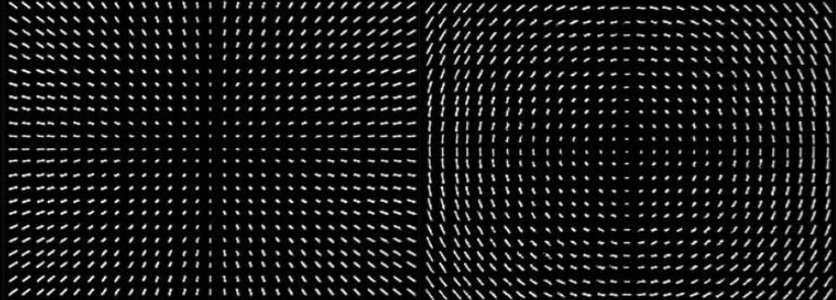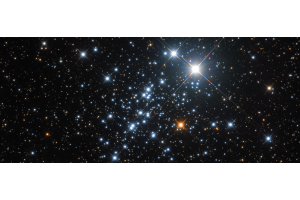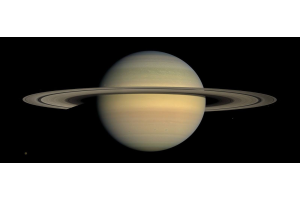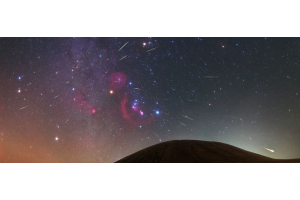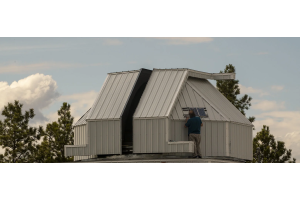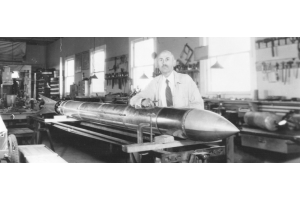
In the past, it was likely the only Ritchey-Chrétien (RC) telescopes you’d find were those in professional observatories and educational institutions. However, in recent years, RCs have become popular due to breakthroughs in manufacturing which have allowed commercial manufacturers to produce these telescopes at a lower expense. For many, the RC’s complexity and inner workings remain somewhat of a mystery. In this article, we will cover the things you should know about RC telescopes and what questions you should ask when looking for the right RC for you.
Collimation can be intimidating, especially for the first time after your new telescope makes a trip from our facility to its new home, and we understand that. Knowing the process of collimation, as well as the intended goal is extremely helpful. We will cover how the two mirrors interact with each other and how they compare to other telescopes. You’ll also learn how to finish the collimation using a star test on your RC, which is not an optional step if maximum performance is desired!
A Step Back In Time
To understand the RC telescope, we must first go back in time and to the basics. Optics are devices that modify light. We must understand that there are two types of optics used for astronomy, those that pass light through the optic and those which reflect light.
Transmittive or Refractive optics use a substrate that is transparent, like clear glass, in order to focus and modify the light. Generally, these types of optics have surfaces which are spherical.
When manufacturing optics, two surfaces are rubbed against each other with abrasive grit or polish. The surfaces are rotated as they are rubbed back and forth on each other. To summarize the process, it is sufficient to say that a spherical surface is the natural state of an optic after working it by hand.
Refractive optics work well in spherical form, though simpler designs can struggle to focus all colors of light equally due to the unequal refractive/prismatic nature of glass. The result of this is that some colors of light are focused further away from the telescope, and some colors focus closer. To counter this issue, multiple glass types and lenses are used in combination to form a good refracting telescope optic. It allows the lens, or objective, to bring the different colors of light closer to the same focus, while also correcting for other aberrations, such as coma, field curvature, and astigmatism. A “perfect” refractive objective would focus all the visual spectrum at exactly the same place. While no perfect objective exists, modern multi-element refractive objectives do a fantastic job at focusing the different wavelengths (colors) of light at nearly the same exact location.
A refracting telescope uses an objective that is relatively lightweight and compact in smaller apertures. Usually the largest refracting scopes you will ever see will be a 5”-6” objective, with most being in the 2”-3” range. These are tiny when compared to other styles of telescopes.
Reflecting telescopes focus light using a mirror. Reflecting telescopes focus all colors of light, including ultraviolet and infrared at the same exact location. Reflecting telescopes are completely free from any chromatic aberration. Early versions of reflectors did not use glass substrate with a reflective overcoating like we see today. They used speculum metal, a polished bronze-like alloy of copper and tin.
Early reflecting telescopes struggled with spherical aberrations. Since optics want to naturally form into a spherical shape, this was the general shape of an astronomical mirror after polishing. Light hitting the outer part of the mirror focused closer, and light hitting the center part of the mirror focused farther away. The spherical shape of the reflective optic needed to have its shape adjusted for best performance. The center of the mirror’s curve needed to be deepened so the light focusing farther away focused a little bit closer, and the edge of the mirror needed to be flattened some so the light focused too close would focus a little farther away. This formed a parabolic mirror. A parabolic mirror focuses all the light which is coming from an “infinite distance,” like a star, to the same position.
While the refracting telescopes focus and form an image behind its objective and behind the telescope, where it was easily accessible, reflectors use concave mirrors to focus light forward. This places the focal position in front of the main optic. The focal point is not visible to a person because their head looking into the eyepiece blocks the light from coming into the telescope. William Herscial accounted for this by tipping the mirror so his head did not interfere with the view, and the mirror looked a bit to the side. The epitome of optical tilt. Another aberration, or optical flaw, of the parabolic mirror is coma. Coma can be seen on the outer parts of the telescope's image as distorted elongated stars. Some consider the stars to be shaped like a comet, or a flying bird; specifically a seagull.
Sir Isaac Newton decided to place a small flat mirror in the path of the primary mirror. This directed the light out of the side of the telescope where it could be accessed with an eyepiece without blocking the light path. The primary mirror is parabolic, and the secondary is a zero power flat mirror. Think of the secondary mirror as something like your bathroom mirror where it does not focus or modify the light in any way, it simply shows you a reflection of the room. This is an over simplification because the secondary mirror in a telescope is not only physically flat, but optically flat. In the case of the Newtonian, the secondary shows you a view of the primary mirror’s focused light cone.
The Gregorian is often considered the first functional, compound reflecting telescope. It used a concave parabolic primary mirror to focus the light, just like the Newtonian. However, the Gregorian has a second concave focusing mirror, rather than the angled, flat mirror that a Newtonian uses. This second concave focusing mirror is positioned just past the focal point of the primary mirror. It then extends the light cone and focuses it through a hole in the center of the main mirror, and out of the back where it was accessible like on a refracting telescope. Due to the nature of the scope and the secondary mirror being far outside the primary mirror's point of focus, it was a physically long telescope, though still much shorter than a refractor of the same focal ratio. The scope was optically long for best performance because the secondary mirror acted like a Barlow lens, multiplying the focal length of the primary mirror. The secondary mirror was elliptical in shape and the primary mirror was parabolic.
Along came the Cassigrain. The Cassegrain was also one of the first compound reflecting telescopes but rather than having a concave secondary mirror outside the focal position of the primary mirror, they have a convex secondary mirror inside the focal position of the primary mirror. Because the secondary mirror is inside of the focus position, the telescope was much shorter, physically, but the optical length is similar to the Gregorian as the secondary mirror of the Cassegrain also acts like a Barlow lens, multiplying the focal length of the primary mirror. The secondary mirror not only acts like a Barlow, but it adds spherical correction to the telescope system. Because of this, the secondary mirror needs to be a hyperbolic shape.
A hyperbola has more correction than a parabola or a sphere. However, a convex mirror has a negative effect on the spherical wavefront, compared to a concave primary mirror. So, we take our parabolic primary mirror, which has the perfect correction to it, and place this convex secondary mirror in front of it. The resulting star images are very over-corrected! They are bloated and don't come to a perfect focus. Because the convex secondary mirror adds correction, and because the convex mirror has a negative effect on spherical correction, forming it into a hyperbola reduces the overall correction of the optical system, and now focuses all light at the same exact place. Just like a parabolic mirror does on its own.
An interesting look at the effects of convex mirrors on spherical aberration is the Dall-Kirkham. It is just like a Cassegrain, but instead uses a spherical convex secondary mirror. Remember how the convex secondary adds correction to the system? Remember that a parabolic mirror on its own focuses light at the same location. Rather than changing the shape of the secondary mirror to make up for this, the shape of the primary mirror is changed instead. It is reduced to about ¾ of the way between a sphere and a parabola. The result is a telescope free from spherical aberration, all of the light comes to a perfect focus at the center of the field. Collimation is more relaxed because of the spherical mirror. A downside is the design has tons more coma than a Cassegrain or a Newtonian.
So far, all of the compound reflecting telescopes perform best with a parabolic primary mirror and a secondary mirror that is also an asphere. All of the reflecting telescopes (including the Newtonian and Dall-Kirkham) have an aberration known as coma, which is that the stars not centered in the field of view (off-axis) have a comet or arrow shape about them. They also have longer system focal ratios. Usually from f/10 up to f/30. These telescopes are all ancient designs for the most part, originating in the Renaissance period. They also have field curvature to some degree, which is when the image formed by the telescope has a shape more reminiscent of a salad bowl, rather than a flatter shape, like a dinner plate.
Cassigrains can be used in Newtonian format by replacing the convex secondary mirror with a flat or simply with a camera (if the scope is large enough) and have the ability to image at short focal ratios or long. Cassigrain and Newtonian scopes both have coma. Coma is not good for astrometry or the mapping of star locations because coma does not have a geometric center that coincides with the point source of light. This makes plotting star positions accurately very difficult.
What is a Ritchey-Chrétien Telescope?
In 1910, George Willis Ritchey and Henri Chrétien created the first working Ritchey-Chrétien telescope. The telescope has an optical layout almost exactly the same as a Cassegrain, and there is no real way to tell the two optical designs apart from a casual glance. The optical differences are so small that mere microns of glass differentiates one telescope from the other.
By over correcting the primary mirror of a Cassegrain, making it a hyperbolic mirror, and subsequently over correcting the secondary mirror to compensate for the spherical aberration of the overcorrected primary, we wind up with a compound reflecting telescope that trades coma for astigmatism. Astigmatic stars look like ellipses rather than comets. Elliptical shapes have a geometric center, and, therefore, their images can be used to create more accurate astrometric measurements. So, the primary mirror has a deeper center than a parabola and an even flatter edge than a parabola.
Another benefit of this telescope optical design in today's modern amateur astronomy field is that the generally round stars look fantastic with moderate camera sensor sizes. Additionally, simple field flatteners, like those used on refractors, can remove much of the residual field curvature seen in the RC scope. Residual astigmatism is very small and a non-issue. This results in a flat field telescope with minimal aberrations.
The RC scope can also be made to perform very well in shorter focal lengths. The primary mirror can be made quite short, say f/2.75, compared to the f/4 or f/5 that is typically seen in Gregorian or Cassigrain scopes. The secondary mirror “Barlow” effect of the RC can also be much smaller, as small as 2.5x, than what is seen in Gregorian or Cassegrain scopes. This results in RC system focal ratios that are commonly around f/8, versus the f/12 to f/14 of Cassigrain systems and the f/18 to f/30 of Gregorian systems. This shorter system focal ratio and need for a larger illuminate field leads to a larger secondary mirror.
Collimation
Collimation is the process of aligning the telescope's optics so they offer the highest level of performance possible. Proper collimation is important for a balanced image with the best star shapes and maximum illumination.
In a Newtonian telescope, collimation is fairly straight forward because the secondary mirror does not modify the light cone. So, if there is a slight decentering or tilt to the secondary mirror in a Newtonian, the end result is quite subtle and typically seen as uneven field illumination or a slight amount of tilt to the image plane. In a Newtonation, many users mistake miscollimation of the secondary mirror as focuser tilt. When collimating a Newtonian, first the secondary is aligned to point at the primary mirror, and then the primary mirror is adjusted to return the image centered on the alignment point.
How is collimation in an RC different from a Newtonian?
The process is not all that different. Though, the implications of a misaligned secondary are more apparent than in a Newtonian. The fundamental difference in the process is that with the small commercially produced RC, the first adjustment is made to the primary, aligning it with a center spot on the secondary mirror. Then the secondary is adjusted to return a centered image.
There are as many ways to collimate as there are days in a week, but we almost always start with a bench collimation. This is an optical alignment that relies on physical alignment points and reflected images. Bench collimation is a rough start that should get us close and is not the final step of aligning optics. Please keep in mind that collimating a Ritchey-Chretien telescope is just as easy as collimating a Newtonian telescope, and it does not need to be difficult or overly complex to produce decent images.
Bench Collimating the 6” and 8” RC
The Apertura Cheshire Collimation Eyepiece is the basic recommended tool for bench collimation because it is cost effective and provides good results. Other tools can be used, but oftentimes, they are as costly as the telescope itself. No matter the tool, the process is generally the same as what is listed below. Make sure to adjust the primary then the secondary.
To collimate an RC telescope with the Apertura CCE, start by removing any cameras or accessories attached to the back of the telescope. Remove the front cover of the telescope. Looking through the empty focuser, take note of the doughnut shaped center spot on the secondary mirror.
Insert the CCE into the 2” to 1.25” adapter supplied with the telescope with the angled reflective side facing up. Then, insert this into the focuser and clamp it in place. Look through the collimation tool and compare the secondary mirror center spot to the collimation tool crosshairs. If adjustments are needed, loosen the three small hex screws near the focuser base. Adjust the primary mirror collimation hardware on the back of the telescope to place the CCE crosshairs at the center of the secondary mirror center spot. Lock the small set screws at the back of the telescope in place, making sure to keep the crosshair centered on the spot.
Trust the crosshairs! Do not go off the “concentric circles” formed by the tool and all of the other parts of the telescope. Just focus on the crosshairs and the secondary mirror center spot.
Now that the primary mirror has been adjusted, take note of the reflective circle from the Apertura CCE. By covering and uncovering the reflective portion of the CCE with your hand while looking through the telescope, it will be apparent which part of the reflection is from the CCE. If the change is not readily apparent, make sure the angled reflector of the CCE is pointing towards a bright light source like a ceiling light or white wall. If you are working in a dark area, a small handheld flashlight can be used to illuminate the reflector.
DO NOT ADJUST THE SECONDARY MIRROR CENTER SCREW!
Doing so will alter the focal length of the telescope and can cause spherical aberration. This spacing is set at the factory. Do not adjust this.
Adjust the secondary mirror collimation hardware until the reflective target is centered on the crosshairs and the secondary mirror center spot. For a long lasting collimation, it is important the hardware has some preload on it.
Never adjust collimation by only loosening the hardware. All final adjustments should be made by only tightening the three screws. If you find they will not turn anymore without damage occurring, then back off just a little bit. Tension here is the key to a lasting optical alignment and an often overlooked step.
Some users might find that making these adjustments in iterations (adjusting the primary, then secondary, then primary again) will help with the ultimate accuracy of the process. Remember that a bench collimation is just a rough start for us pixel peepers and not the be all end all of perfectly aligning optics!
Recap:
- The primary mirror and focuser are adjusted as one unit to point at the center of the secondary mirror.
- The secondary mirror is adjusted to return this image to the center.
We highly discourage the initial use of a focuser tilt plate accessory. It is important to be successful at basic collimation before adding other accessories into the system. Only once you are comfortable and confident with the factory included hardware, should you add additional adjustments to the telescope, if desired.
Star Collimation
Now that the telescope has been bench collimated, it’s time to move to a star test. Start by attaching your camera to the telescope. Then, set up your imaging rig and achieve focus with the system. During star testing, we’ll only adjust the primary mirror.
Step One
- Center a moderately bright star, such as a constellation star, in your field of view. Using a live view or looping short exposure, center this star perfectly in your camera. Then, ever so slightly defocus the star. You’ll need to zoom in using your imaging software to see the details necessary. If the star is defocused too much, the detail necessary to perfect the collimation will not be visible. If the shadow of your secondary is not centered in the unfocused star image, you will see something like this:
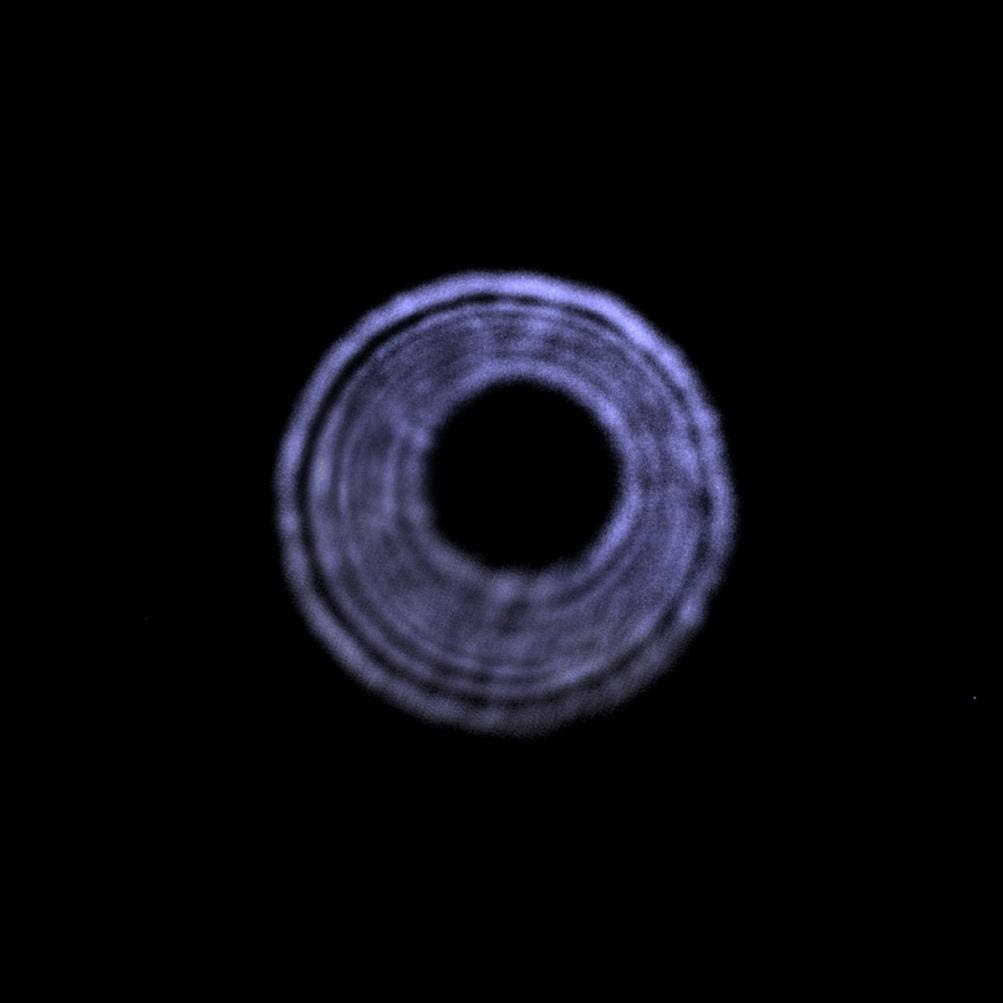
Step Two
- This telescope is in poor collimation. The question now is which of the three screws do you need to adjust to bring the telescope into a better state of alignment. To find out, simply reach your hand around and place it in front of the telescope’s aperture. Then move your hand’s orientation so its silhouette is seen in front of the widest portion of defocused light between the shadow of the secondary and the edge of the star. In doing so, you will see something like this:
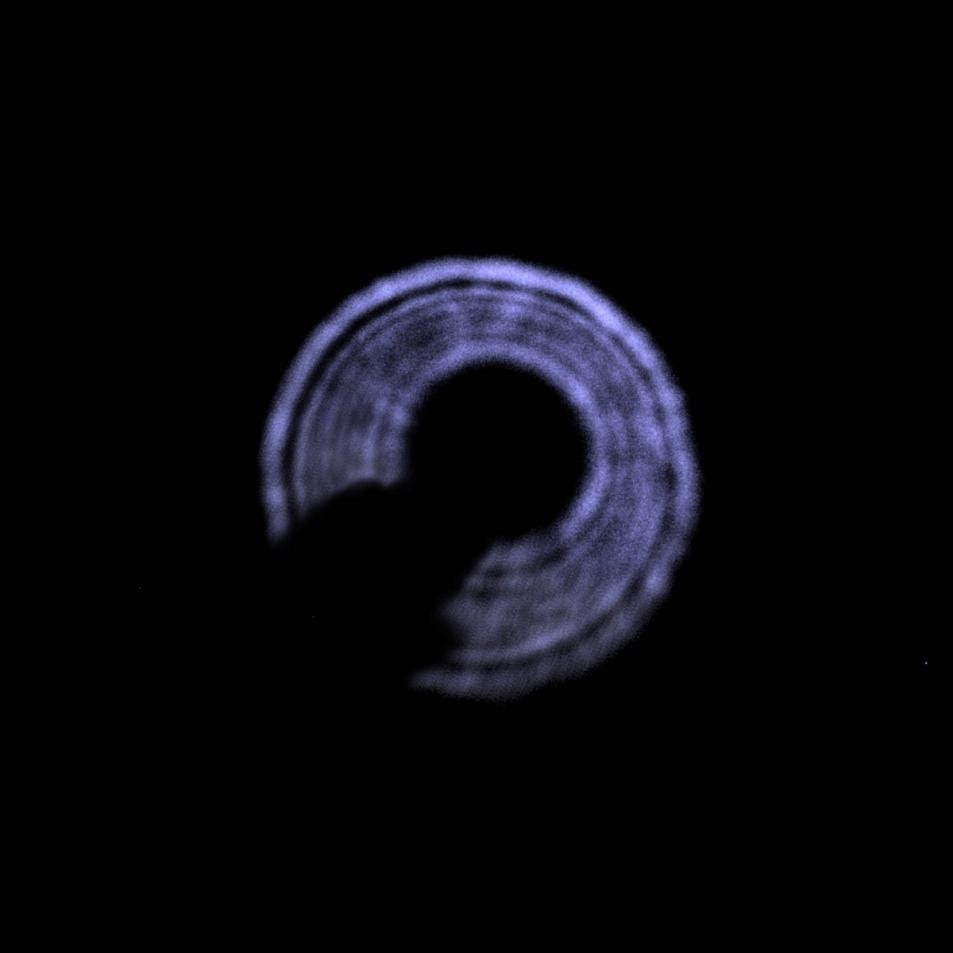
Step Three
- Once this is accomplished, look at the primary collimation hardware (at the back of the telescope) and see which one of those screws best aligns with your hand placement. If you are lucky enough to find a collimation screw in the same orientation, then you will need to adjust that particular adjustment screw. If, however, your hand is between two collimation screws, then adjust the screw on the opposite side. The goal is to find a screw that is closest to the imaginary line that your hand creates across the telescope.
- Make very small adjustments to the collimation screw, always recentering the star within your view to see the results of your efforts. If the collimation looks worse, then you are turning the screw in the wrong direction. You may need to adjust more than one screw to finalize collimation. However, you can use the trick mentioned earlier to see exactly which screw needs to be adjusted. Be patient and make small changes until you see something like this:
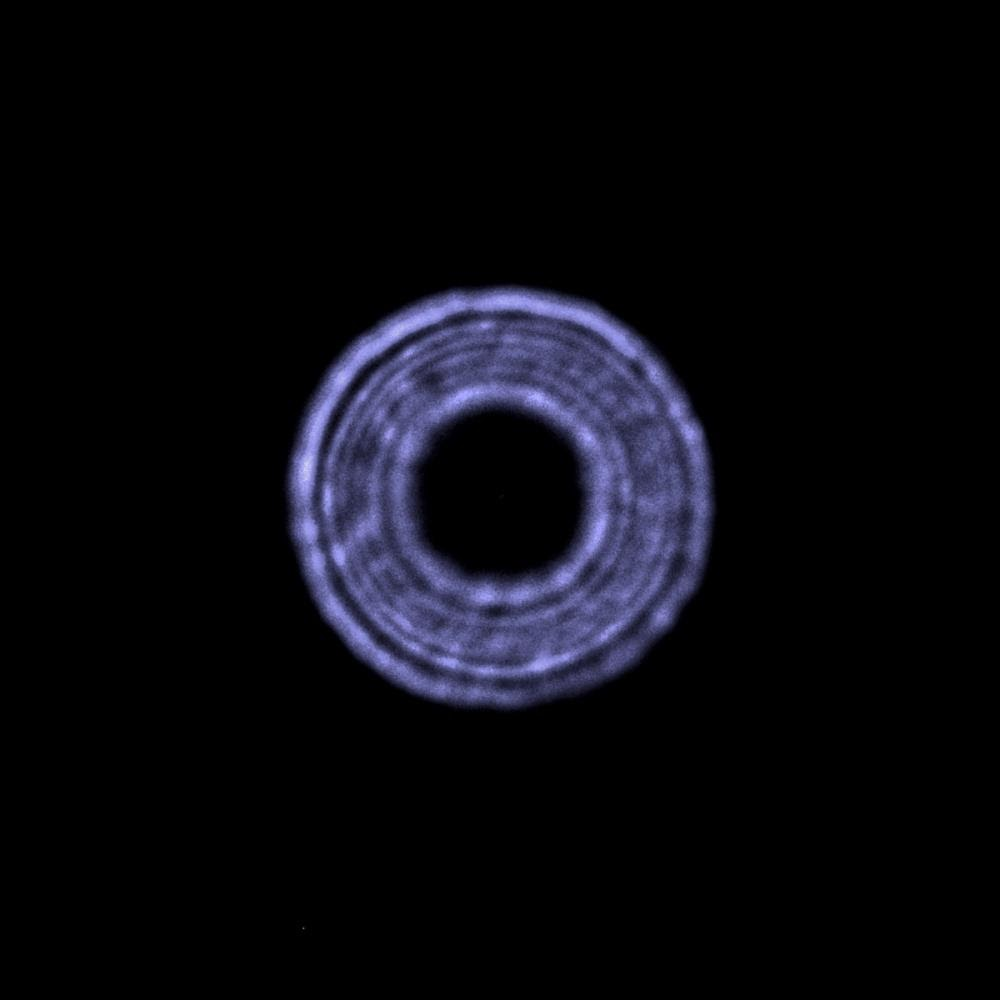
Step Four
- Short focal ratio imaging Newtonians will have a secondary mirror that is physically offset from the center of the tube. It might be a small amount, but it is offset. This offset can show in a star test if the star is defocused too far, and because of that fact, it is important to work through the following final step.
- For some extra precision, tweak your focus a bit so that the star is just slightly outside of perfect focus. If your telescope is perfectly collimated, you should see a tiny white dot centered within the shimmering diffraction pattern. This small dot is called “Poisson’s Spot,” and it determines the true center of your diffraction pattern. Only when this spot is precisely centered can you call your work done. If it is off slightly, just keep making small tweaks to one or more of your collimation screws while keeping the star image as well centered as you can. If you are patient and persistent, you will end up seeing something like this:

Once the axis star looks good, you’re going to move on to the secondary mirror. Please be sure the small lock screws for the primary are secure before moving on to the secondary mirror.
Now that the primary has been adjusted, bring the scope back into focus. Point the scope at a bright starfield and take an image. What do the stars in the corner of the frame look like? Are they balanced? Meaning, do all the corners look similar? It is normal for the extreme corners to have stars that might be slightly oblong in either direction. This is astigmatism and field curvature and is a normal part of an RC telescope. The corners should look like one of the following two images:
You might notice that one of the corners is quite different from its opposing corner. If the stars look like one of the following images, then you need to adjust the secondary mirror to balance the image:
In these instances, you’ll typically want to adjust the secondary mirror so it moves across this angle. Choose a collimation screw that corresponds with this axis and make an adjustment, noting if the corner stars get better or worse. If they get better, keep adjusting. If they get worse, move the screw in the opposite direction. After some careful iterations, you should wind up with a star field that looks balanced from corner to corner.
In the event you can not fully balance the image, get it as close as you can, and then go back and recheck the primary. It is likely that the system was far off and the primary needs a small adjustment before coming back to the secondary mirror. It is not abnormal to go back and forth from primary to secondary when really trying to perfect the star images.
Learning about RC telescopes and collimation is a great way to shake off the mystery about both this unique telescope and the process. Taking your time, learning, and working through the above procedures will allow for picture perfect stars. While this information gives you a lot to consider, the end result is worth it!

Learn More
Interested in diving deeper into the world of astronomy? Check out our AstronomyHub for a wealth of articles, guides, local resources for planetariums and observatories near you, and more to enhance your stargazing experience.





